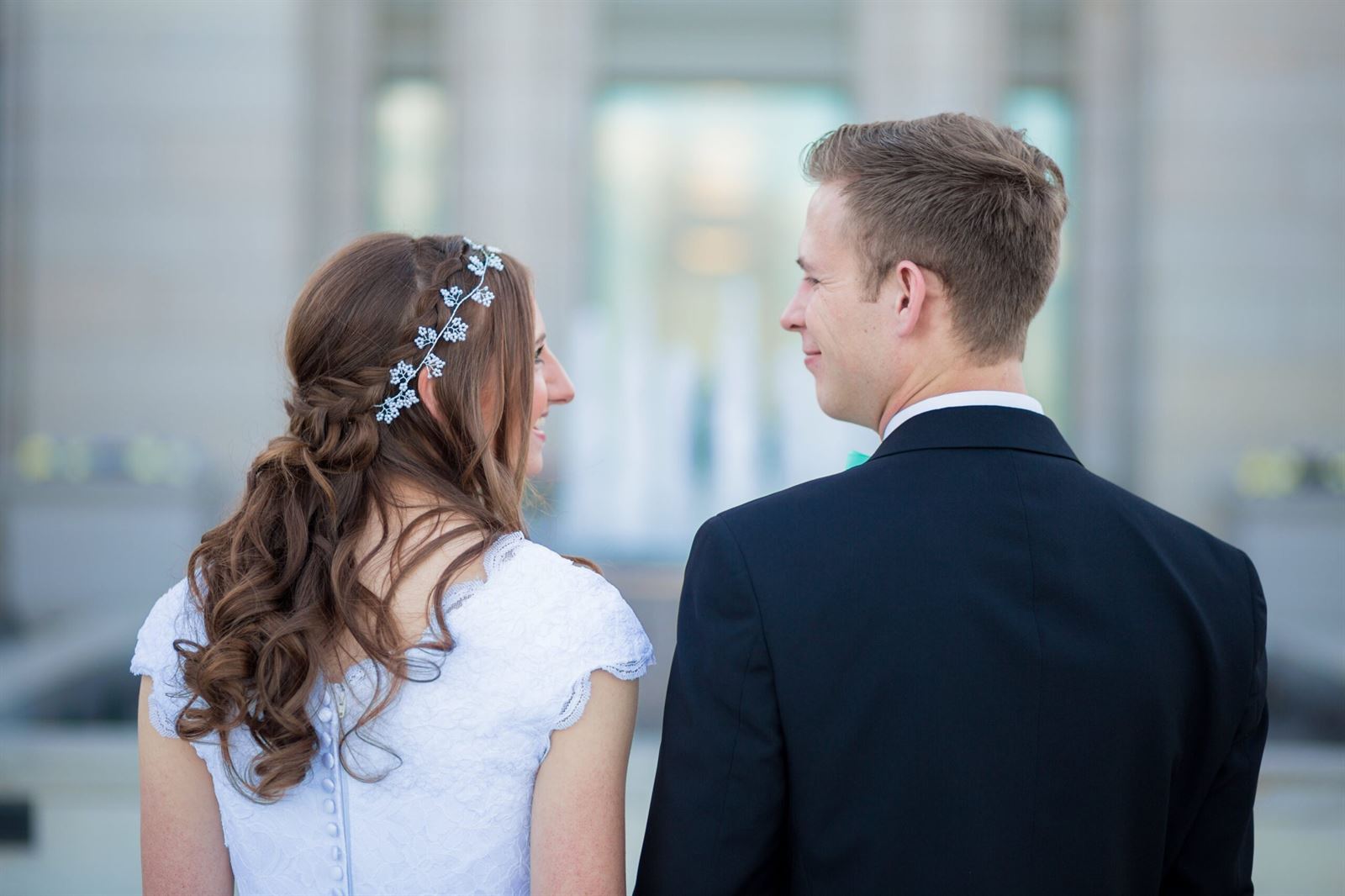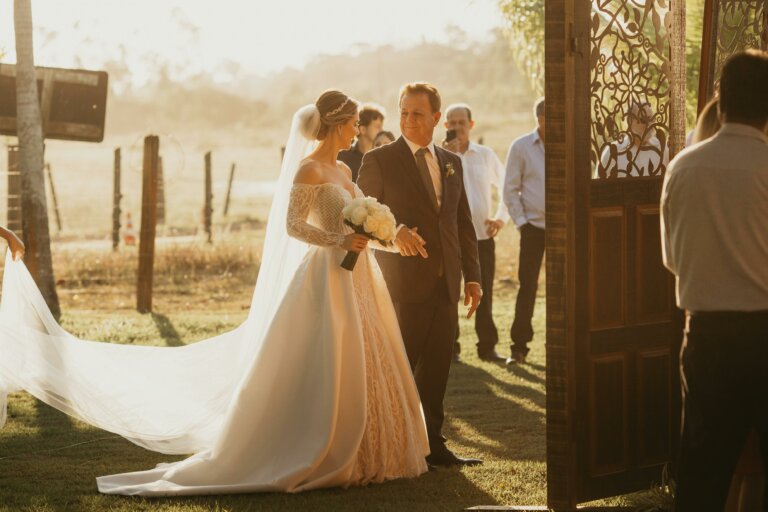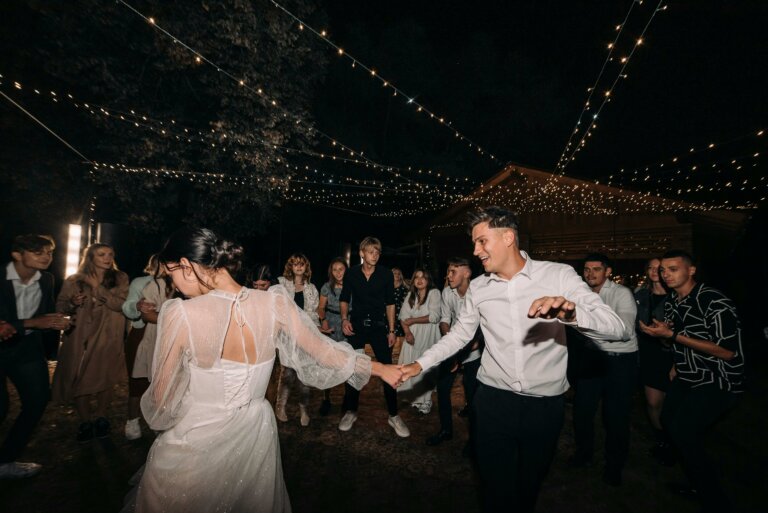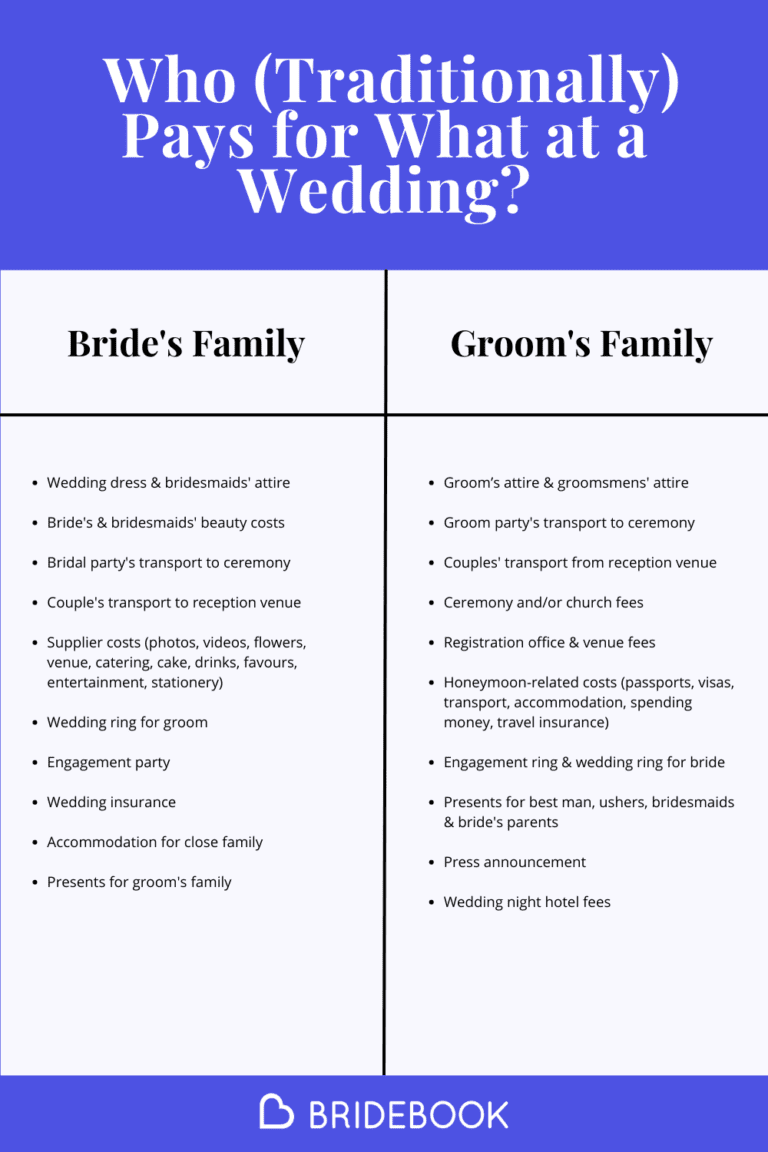Wedding Etiquette: Who (Traditionally) Pays For What?


You’re engaged to your best friend, your partner in crime, your ride or die – now it’s time to start planning the biggest party you’ll ever throw.
The first thing on your mind is likely to be, ‘How much is all of this going to cost?’ In Australia, the average amount couples spend on their wedding is an eye-watering is approximately $34,000. Once you know that, the second question you might ask is, ‘How are we going to pay for it?’
No need to panic – we’ve got a super powerful budget tool which uses thousands of couples’ real budgets to estimate the total cost of your wedding and then break that down so you have a good idea of exactly what each part will cost.
But, if you’re looking to do things a little more traditionally, and get generous family members involved, who pays for what in a wedding?
Some families offer to help the newlyweds-to-be celebrate the most magical day of their lives, and we’re here to give you the lowdown on who traditionally (a big emphasis on the traditionally) pays for what. Once you’ve calculated your budget and seen how much everything’s going to cost, you and your partner can both let your families know what they can help with. At the end of the day, it’s whatever works for you and your family.
If you don’t want to know about the why’s and how’s of these costs and want to get straight into what each side of the family should pay for, skip ahead to our quick reference cheat sheet!
Should the bride’s family pay for a wedding?

Beliefs and expectations have evolved, and in the 21st century, it’s no longer the case that the bride’s family are expected to pay. Now, in Australia and many cultures around the world, the bride’s family and the groom’s family – as well as the couple themselves – can help pay for a wedding.
The modern way to split paying for a wedding looks a little something like this:
- Bride’s family – 25%
- Groom’s family – 25%
- The couple – 50%
With this in mind, based on the average cost of a wedding being $34,000, that still leaves you with around $17,000 you might have to save yourself – and that’s if your family can lend a hand.
Should you ask the bride’s family to pay for your wedding?
While it may have once been the traditional way to pay for a wedding, you should only ask the bride’s family to pay for your wedding if you know they can comfortably afford it. The same goes for asking the groom’s family. You’ll want to make sure they’re fully on board with your marriage plans, which might mean a lot of buttering up and being an exemplary son or daughter and future in-law.
The important thing to remember is not to go in expecting anyone to pay. Talking about money is personal, private and sometimes awkward. But, it can be done carefully without causing friction.
Who traditionally pays for different parts of a wedding in Australia?

If you’re lucky enough to have family who want to help you pay for your wedding, then the below guide should give you an indication of who might pay for what.
Before we dive in, each of these traditions is based on there being a bride and groom. Many modern couples have two grooms or two brides – or perhaps neither. If you’re an LGBTQ+ couple planning your big day, we recommend that you try to evenly split what you ask your families to pay for and use the below as a rough guide.
Who traditionally pays for an engagement party?
This expense is traditionally covered by the bride’s family, since they often host the engagement party at their house as a way to welcome and bring together the two families (often for the first time). However, whichever family is feeling the most generous can offer to host or throw the engagement party. It all depends on space, funds and who wants to do the clearing up afterwards.
Who traditionally pays for the rehearsal dinner?
Since the bride’s family pays for the engagement party, the rehearsal dinner is traditionally paid for by the groom’s parents. They should only spend what they’re comfortable with, however, and hosting a small soirée the day before the wedding is more than enough.
Not all couples choose to have a rehearsal dinner, so you may ask for this contribution to go towards the big day itself, instead.
Who traditionally pays for the wedding venue?
The venue is usually the single biggest expenditure of your entire wedding, and no one is pleased to be handed an invoice with that many zeros on it. Traditionally, this would be something that the bride’s parents would pay for and covers the cost of the ceremony itself.
Because the average wedding venue costs between $14,000 and $17,000, this can be a heck of a cost to expect one family to pay for alone. So, for more modern weddings, this is something that many families – together with the couple – split the bill for.
Who traditionally pays for wedding catering?
This is another cost that traditionally lies with the bride’s family, which includes the cost of canapés and the evening buffet. The good news is that it’s not traditional for the bride’s parents to cover the cost of an open bar, with most weddings having a cash bar, so guests pay for their own drinks.
Who traditionally pays for the wedding reception?
The bride’s family traditionally pays for the wedding reception, though the costs do cross over with that of the venue, entertainment, decor and food.
Because of this, the more modern take on it is to split the cost between the bride’s and groom’s families, as well as the couple themselves.
Who traditionally pays for wedding transport?
Traditionally, wedding transport is paid for by both families. If you’re hiring transport for your guests, then this isn’t traditionally something your guests will be expected to pay for.
Who traditionally pays for a wedding photographer or videographer?
Your wedding photographer (and/or videographer if you choose to hire one) is traditionally paid for by the bride’s family.
For modern weddings, this might be something that the couple prefers to pay for themselves.
Who traditionally pays for wedding flowers?
Traditionally, the groom pays for the bride’s bouquet. For an extra romantic twist, the groom could even pick wildflowers to be included as well. On the other hand, the bride’s side of the family will traditionally pay for all the floral decorations.
For modern weddings, the flowers are something that the couple will pay for, including the bouquet and floral decorations.
Who traditionally pays for the wedding cake?
The wedding cake is traditionally paid for by the bride’s family, but this isn’t a tradition stuck to quite as closely as others. Many couples now choose to pay for their own cake, in part due to the traditions involved with cutting the cake and how it represents sharing everything.
Who traditionally pays for the wedding dress?
One of the most closely stuck-to traditions is that the bride’s family will pay for the wedding dress. This also includes any accessories the bride may wear, such as a veil, a bag and shoes.
For modern weddings, the bride may want to pay for her own dress. But, the bridal party are still encouraged to attend fittings for all the fun and excitement that goes with it.
Who traditionally pays for the groom’s suit?
The groom’s family would traditionally pay for the groom’s suit and any accessories, such as a tie, shoes and pocket square. Nowadays, it’s more likely to be one of the expenses that the groom will take care of himself.
Who traditionally pays for wedding rings?
Traditionally, the cost of the wedding rings is split between the two families. But, wedding rings are super personal – they’re pieces of jewellery the two of you will likely wear all day for the rest of your lives and have a huge amount of meaning. For that reason, many couples choose to pay for their wedding rings themselves these days.
Who traditionally pays for the engagement ring?
Traditionally, whoever proposes is the one who will pay for the engagement ring. Another option is to use a family heirloom which has been passed down from parents or grandparents.
Some modern couples will buy an engagement ring together. This might take away the element of surprise when it comes to the proposal itself, but it can be a lot of fun shopping for an engagement ring together. Other couples might choose to wear an engagement ring each, and those who do this might pay for the rings together.
Who traditionally pays for the bridesmaids’ dresses?
The bride’s side of the family traditionally pays for the bridesmaids’ dresses. But, with modern weddings, it’s becoming more common for bridesmaids to pay for their own dresses. It really depends on what your budget is, the type of dresses you want your bridesmaids to wear, and whether or not that’s within their price range. To avoid confusion later, we’d recommend discussing this as early as possible with your wedding squad.
Don’t know who should pay for your bridesmaid’s dresses? Read our guide on what your bridesmaids should and shouldn’t pay for.
Who traditionally pays for the groomsmen’s suits?
Unless they’ll be matching or require special suits, the ushers traditionally pay for their own attire. If the suits need to be tailor-made, however, it’s an expense that the groom’s side should cover.
Who pays for wedding guests’ accommodation?
Traditionally, each side of the family pays for their own guests’ accommodation. However, this really depends on what the families are comfortable with, as most guests pay for their own accommodation nowadays. Most hotels charge north of $200 a night, and if you decide to cover the bill, that could set you back thousands. Thankfully, very few couples offer to pay for their guests’ accommodation, so it’s not something they’ll expect.
Who traditionally pays for a hen party?
Traditionally, the hens will pay for most aspects of a hen party, with the maid of honour taking the responsibility of arranging everything and making those important bookings.
Today, there are no set rules – it entirely depends on budgets and plans. Make sure you and your hens discuss all your options and what everyone expects early on.
Who traditionally pays for the bucks party?
It’s tradition for the groomsmen attending the bucks party to pay, but it all depends on budgets and what the planned activities are. For something more expensive, like a trip abroad, it’s fine to ask the groom to contribute towards costs.
Who traditionally pays for a honeymoon?
Traditionally, it’s the groom who pays for the honeymoon. Today, however, most couples split the cost, with many also asking for donations towards their honeymoon instead of wedding gifts. This is a relatively new tradition, which likely stems from the fact that people are generally getting married later and often already live together by the time they tie the knot. That means they probably don’t need (or want) a new toaster or a 24-piece dinnerware set!
Who pays for what at a wedding: the quick reference cheat sheet
If you’re looking for a list of who traditionally pays for what, check out our quick reference cheat sheet below:

What does the bride’s family traditionally pay for at a wedding?
Traditionally, the bride’s family would pay for the majority of the major costs:
- The wedding dress or outfit (and any accessories that come with it)
- Bridesmaids’ dresses and accessories (NB. Nowadays, more and more bridesmaids pay for their own attire)
- Any accompanying outfits for the bride (for example, going-away or honeymoon outfits)
- Hair and makeup (along with other beauty treatments)
- Transportation to the ceremony for the bridal party
- Transportation to the reception venue for the bride and groom
- Photography and/or videography
- Flowers
- Venue hire and decorations
- Wedding cake
- Catering
- Wedding favours
- Drinks
- Entertainment
- Wedding stationery
- The groom’s wedding ring
- Engagement party
- Wedding insurance
- Overnight accommodation for close family
- Presents for the groom’s family
What does the groom’s family traditionally pay for at a wedding?
Traditionally, the groom’s family doesn’t have to pay as many wedding-related costs, but there are still plenty of ways they can get their hands in their pockets:
- The groom’s outfit
- The best man’s suit and ushers’ outfits (NB. As with the bridesmaids, these now tend to be bought by the groomsmen themselves)
- Groom’s going-away outfit
- Transportation to the ceremony for the groom and best man
- Transportation for the bride and groom from the reception venue
- Buttonholes for all the groomsmen
- Civil or religious ceremony fees
- Church fees (plus any extras like church music and bell ringing)
- Registration office and other venue fees
- Travel, accommodation (and if required: visas) for the honeymoon
- Spending money for the honeymoon
- Travel insurance for the honeymoon
- Bride’s engagement and wedding rings
- Presents for the bridesmaids, ushers and best man
- Presents for the bride’s parents
- Press announcement for the wedding
- Wedding night hotel fees
Plan your dream wedding on Bridebook
While some couples and their families choose to abide by traditions, things are quickly changing, so you shouldn’t feel obliged to stick to any of them. It’s down to you and your family to decide who pays for what, so everyone feels included and no one feels pressured to spend beyond their means.
Whatever you and your partner decide, make sure you keep on top of it with our free wedding planning tools, and everything will be just fine. Be sure to also download our free Bridebook app for quick and stress-free planning.


